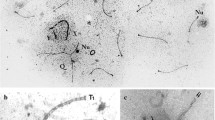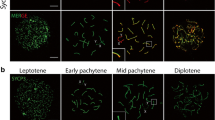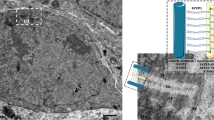Abstract
Surface spread spermatocytes of mice heterozygous for a tandem duplication show nuclei in late zygotene-early pachytene in which the heteromorphic synaptonemal complex (SC) contains a lateral element that is buckled out into an unpaired loop as a consequence of the added length of the duplication (estimated in another study to be 21.7%, with breakpoints at 0.50 and 0.72 of the length of the chromosome). The ends of the buckle, marking the interstitial termini of synapsis proceeding from opposite directions, vary over a wide range of positions, but within limits: the proximal end of the loop does not exceed the distal end of the duplication segment, while the distal end of the loop does not lie closer to the kinetochore than the proximal end of the segment. Thus, synapsis (SC formation) at zygotene is restricted to homologous regions (exclusive homosynapsis). — In the last half of pachytene, no buckles are found, only simple SCs with lateral elements of equal length, as a consequence of synaptic adjustment. Intermediate stages of adjustment are found throughout the first half of pachytene. Shortly after homosynapsis is complete, synaptic adjustment begins: the ends of the duplication loop separate (desynapsis of homosynapsed regions); the long axis shortens with respect to the short axis in both the unpaired loop and in the SC portions; asymmetrical twists take up inequalities; the loop is reduced to from 1 to 3 asymmetrical twists; the axes (lateral elements) equalize as the long axis shortens; and a simple SC is formed, indistinguishable from others in the complement, in which the region of the duplication and those adjacent to it have heterosynapsed, while the distal regions of the SC are presumably still homosynapsed. Synaptic adjustment evidently involves two sequential events: localized instability of the homosynapsed condition, leading to desynapsis, then restoration of the SC by heterosynapsis. Adjustment therefore represents the loss of strict homosynapsis. It is concluded that the asymmetry produced by the duplication loop constitutes an instability that triggers synaptic adjustment.
Similar content being viewed by others
References
Burnham, C.R.: The association of non-homologous parts in a chromosomal interchange in maize. Proc. 6th Int. Cong. Genet. 2, 19–20 (1932)
Comings, D.E., Okada, T.A.: Mechanism of chromosome pairing during meiosis. Nature (Lond.) 227, 451–456 (1970)
Dresser, M.E., Moses, M.J.: Synaptonemal complex karyotyping in spermatocytes of the Chinese hamster (Cricetulus griseus). IV. Light and electron microscopy of synapsis and nucleolar development by silver staining. Chromosoma (Berl.) 76, 1–22 (1980)
Gillies, C.B.: The nature and extent of synaptonemal complex formation in haploid barley. Chromosoma (Berl.) 48, 441–453 (1974)
Gillies, C.B., Rasmussen, S.W., D. von Wettstein: The synaptinemal complex in homologous and nonhomologous pairing of chromosomes. Cold Spr. Harb. Symp. quant. Biol. 38, 117–122 (1973)
Grell, R.F.: A new hypothesis on the nature and sequence of meiotic events in the female of Drosophila melanogaster. Proc. nat. Acad. Sci. (Wash.) 48, 165–172 (1962)
Hotta, Y., Bennett, M.D., Toledo, L.A., Stern, H.: Regulation of R-protein and endonuclease activities in meiocytes by homologous chromosome pairing. Chromosoma (Berl.) 72, 191–201 (1979)
McClintock, B.: The association of nonhomologous parts of chromosomes in the mid-prophase of meiosis in Zea mays. Z. Zellforsch. 19, 191–233 (1933)
Menzel, M.Y., Price, J.M.: Fine structure of synapsed chromosomes in F1 Lycopersicon esculentum-Solanum lycopersicoides and its parents. Amer. J. Bot. 53, 1079–1086 (1966)
Moses, M.J.: The relation between the axial complex of meiotic prophase chromosomes and chromosome pairing in a salamander (Plethodon cinereus). J. biophys. biochem. Cytol. 4, 633–638 (1958)
Moses, M.J.: Synaptinemal complex. Ann. Rev. Genet. 2, 363–411 (1968)
Moses, M.J.: Synaptonemal complex karyotyping in spermatocytes of the Chinese hamster (Cricetulus griseus). I. Morphology of the autosomal complement in spread preparations. Chromosoma (Berl.) 60, 99–125 (1977a)
Moses, M.J.: The synaptonemal complex and meiosis. In: Molecular human cytogenetics (R.S. Sparkes, D. Comings and C.F. Fox., eds.), pp. 101–125, New York: Academic Press 1977b
Moses, M.J.: Microspreading and the synaptonemal complex in cytogenetic studies. In: Chromosomes today 6, 71–82 (1977c)
Moses, M.J.: New cytogenetic studies on mammalian meiosis. In: Animal models in human reproduction (M. Serio, ed.), pp. 169–190. New York: Raven Press (1980)
Moses, M.J., Slatton, G.H., Gambling, T.M., Starmer, C.F.: Synaptonemal complex karyotyping in spermatocytes of the Chinese hamster (Cricetulus griseus). III. Quantitative evaluation. Chromosoma (Berl.) 60, 345–375 (1977a)
Moses, M.J., Poorman, P.A., Russell, L.B., Cacheiro, N.L., Solari, A.J.: The synaptonemal complex and a tandem duplication in the mouse. J. Cell Biol. 75, 135a (1977b)
Moses, M.J., Poorman, P.A., Russell, L.B., Cacheiro, N.L., Roderick, T.H., Davisson, M.T.: Synaptic adjustment: two pairing phases in meiosis. J. Cell Biol. 79, 123a (1978)
Poorman, P.A., Moses, M.J., Russell, L.B., Cacheiro, N.L.A.: Synaptonemal complex of mouse chromosomal rearrangements I. Cytogenetic observations on a tandem duplication. Chromosoma 81, 507–518 (1981)
Rasmussen, S.W.: Chromosome pairing in triploid females of Bombyx mori analyzed by three dimensional reconstructions of synaptonemal complexes. Carlsberg Res. Commun. 42, 163–197 (1977)
Rhoades, M.M., McClintock, B.: The cytogenetics of Maize. Botan. Rev. 1, 292–325 (1935)
Russell, L.B., Russell, W.L., Cacheiro, N.L.A., Vaughan, C.M., Popp, R.A., Jacobson, K.B.: A tandem duplication in the mouse. Genetics 80, s71 (1975)
Russell, L.B., Russell, W.L., Popp, R.A., Vaughan, C., Jacobson, K.B.: Radiation-induced mutations at mouse hemoglobin loci. Proc. nat. Acad. Sci. 73, 2843–2846 (1976)
Stern, H., Hotta, Y.: Biochemistry of meiosis. Phil. Trans. roy. Soc. Lond. B 277, 277–294 (1977)
Ting, Y.C.: Synaptonemal complex of haploid Maize. Cytologia (Firenze) 38, 497–500 (1973)
Westergaard, M., Wettstein, D. von: The synaptinemal complex. Ann. Rev. Genet. 6, 71–110 (1972)
Author information
Authors and Affiliations
Rights and permissions
About this article
Cite this article
Moses, M.J., Poorman, P.A. Synaptonemal complex analysis of mouse chromosomal rearrangements. Chromosoma 81, 519–535 (1981). https://doi.org/10.1007/BF00285847
Received:
Accepted:
Issue Date:
DOI: https://doi.org/10.1007/BF00285847




